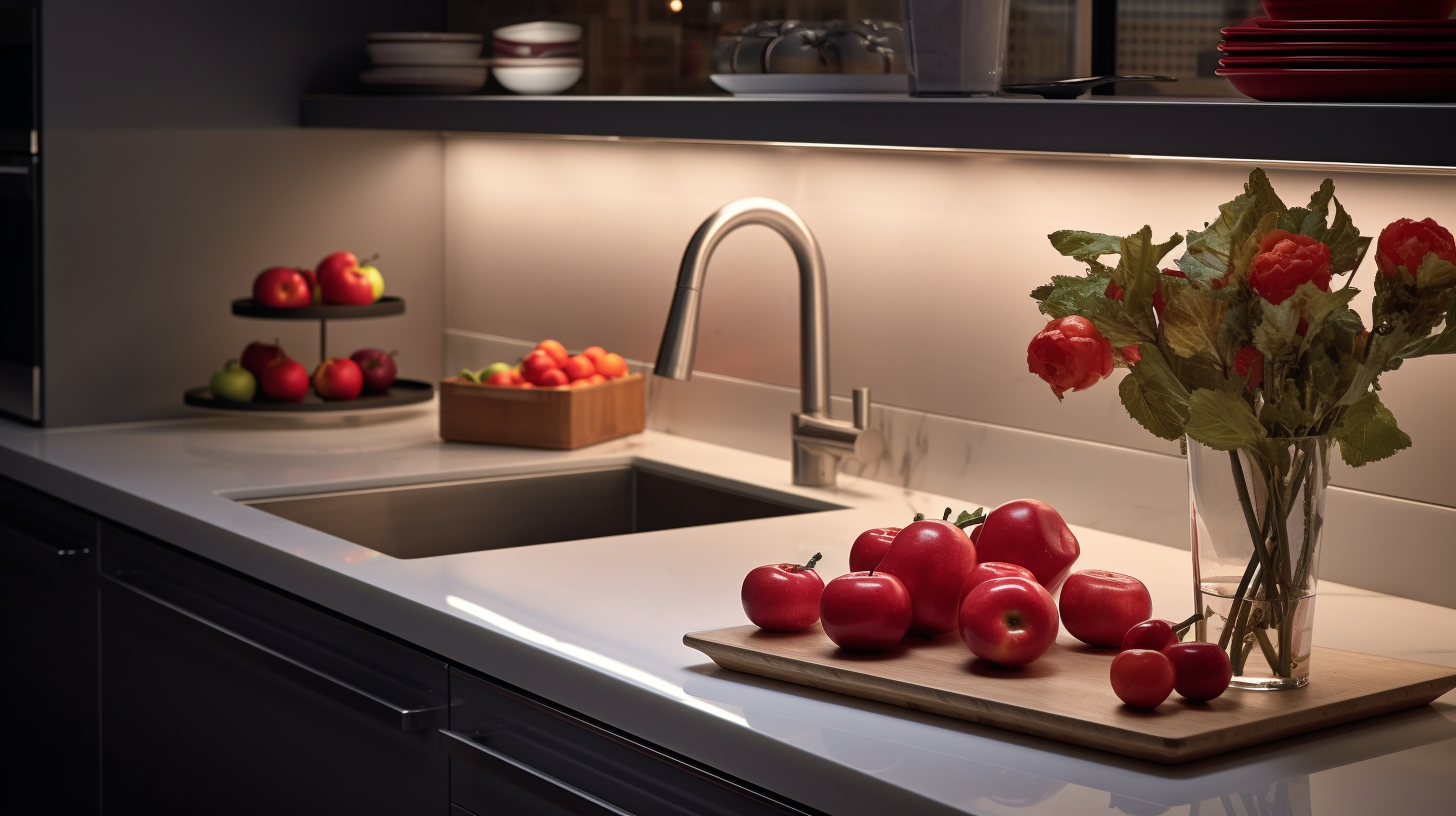The incorporation of smart lighting into kitchen designs has the potential to revolutionize the functionality and aesthetics of the space. By utilizing smart lighting, individuals can effortlessly tailor the ambiance and atmosphere to their preferences.
This versatile lighting system enables the provision of task lighting for efficient utilization of kitchen islands and worktops, ambient lighting to establish a desired mood, and accent lighting to highlight visually captivating areas. Bright overhead lighting can be achieved with LED lighting or spotlights, while dimmer switches facilitate adjustable lighting and energy conservation.
The integration of LED strip lighting beneath cabinets or along plinths further enhances the flexibility of smart lighting. By skillfully combining diverse lighting styles and finishes, an exciting and personalized kitchen can be created without compromising a unified visual appeal.
The importance of proper lighting in the kitchen, as discussed in previous knowledge, is crucial in transforming the feel and atmosphere of the space, allowing for flexible use and coordination with the kitchen aesthetic.
When it comes to lighting design tips, incorporating smart lighting technology can significantly enhance the functionality and ambiance of the kitchen. Smart lighting systems offer various features, such as adjustable brightness, color temperature control, and remote control capabilities. These technologies provide convenience and flexibility, allowing users to easily customize the lighting according to their needs and preferences.
Additionally, smart lighting can be integrated with other smart home devices, such as voice assistants or motion sensors, further enhancing the overall kitchen experience. By leveraging smart lighting technology, homeowners can create a well-lit and adaptable kitchen environment that caters to their specific requirements.
To enhance the style of your home, consider incorporating authentic lighting features that complement the era of your Georgian, Edwardian, or 70s Terrace kitchen. Mixing styles and DIY kitchen ideas can add creativity and personality to your space.
When it comes to mixing styles, it is important to consider scale and balance, as well as creating dimension and depth through the use of various textures and styles. Experimenting with different lighting styles in different areas of the kitchen can bring excitement and a cohesive look to the overall design.
For a DIY approach, consider adding ceiling roses around a pendant for an interesting detail or using low level pendants or lamps to create zones within a 70s Terrace home. By paying attention to these details, you can transform your kitchen into a unique and visually appealing space.
Overall, LED lighting offers a range of benefits, from its energy efficiency to its versatile placement options, making it an excellent choice for illuminating the kitchen.
Key Takeaways
- Proper lighting can transform the feel and atmosphere of a kitchen.
- Different types of lighting, such as task, ambient, and accent lighting, serve different purposes in the kitchen.
- Complementing the lighting style to the era of your home can enhance its overall aesthetic.
- Lighting should be considered during the kitchen planning process to ensure it meets your needs and preferences.
Importance of Lighting
Types of Lighting
Task lighting is essential for illuminating functional areas in the kitchen, such as kitchen islands and worktops. In order to choose the right lighting fixtures for your kitchen, it is important to consider the advantages of smart lighting. Smart lighting offers a range of benefits, including energy efficiency, convenience, and customization options. By using smart lighting, you can easily adjust the brightness and color temperature of the lights to suit your needs. Additionally, smart lighting can be controlled remotely through smartphone apps or voice assistants, allowing you to easily turn lights on or off, set timers, or create preset lighting scenes. When choosing lighting fixtures, it is important to consider the size and layout of your kitchen, as well as the style and aesthetic you are aiming for. Opt for fixtures that provide adequate illumination for your specific task areas, while also complementing the overall design of your kitchen.Complementing Your Home's Era
Highlighting the Dining Table
Linear chandeliers or multiple light sources can effectively highlight rectangular dining tables in the kitchen. This particular lighting arrangement brings attention to the dining area and enhances its visual appeal. To further explore the significance of highlighting the dining table, consider the following points:- Enhancing functionality: Proper lighting over the dining table allows for a more enjoyable dining experience, as it ensures that the table is well-lit for activities such as eating, socializing, or working.
- Creating a focal point: By using linear chandeliers or multiple light sources, the dining table becomes the centerpiece of the kitchen, drawing the eye and creating a visually striking element.
- DIY kitchen ideas: Incorporating linear chandeliers in the kitchen can be a fun and creative DIY project. With a wide range of options available, individuals can customize their lighting to fit their personal style and add a unique touch to their kitchen decor.
Benefits of LED Lighting
LED lighting offers numerous advantages, including its versatility, energy efficiency, and low maintenance requirements. LED lights can be placed in various areas of the kitchen, providing both functional and decorative illumination. These lights are highly versatile and can be used for under-cabinet lighting, spot lighting, and strip lighting. The energy efficiency of LED lighting is a significant benefit, as it consumes less energy compared to traditional incandescent or fluorescent lights. This not only helps to reduce electricity costs but also contributes to environmental sustainability. Additionally, LED lights have a long lifespan and require minimal maintenance, making them ideal for areas that are difficult to access or require constant illumination. The following table provides a comparison of LED lighting with traditional lighting options:| Features | LED Lighting | Incandescent Lighting | Fluorescent Lighting |
|---|---|---|---|
| Energy Efficiency | High | Low | Moderate |
| Lifespan | Long | Short | Moderate |
| Maintenance Requirements | Low | High | Moderate |
| Heat Emission | Low | High | Moderate |
| Versatile Placement | Yes | Yes | Limited |
